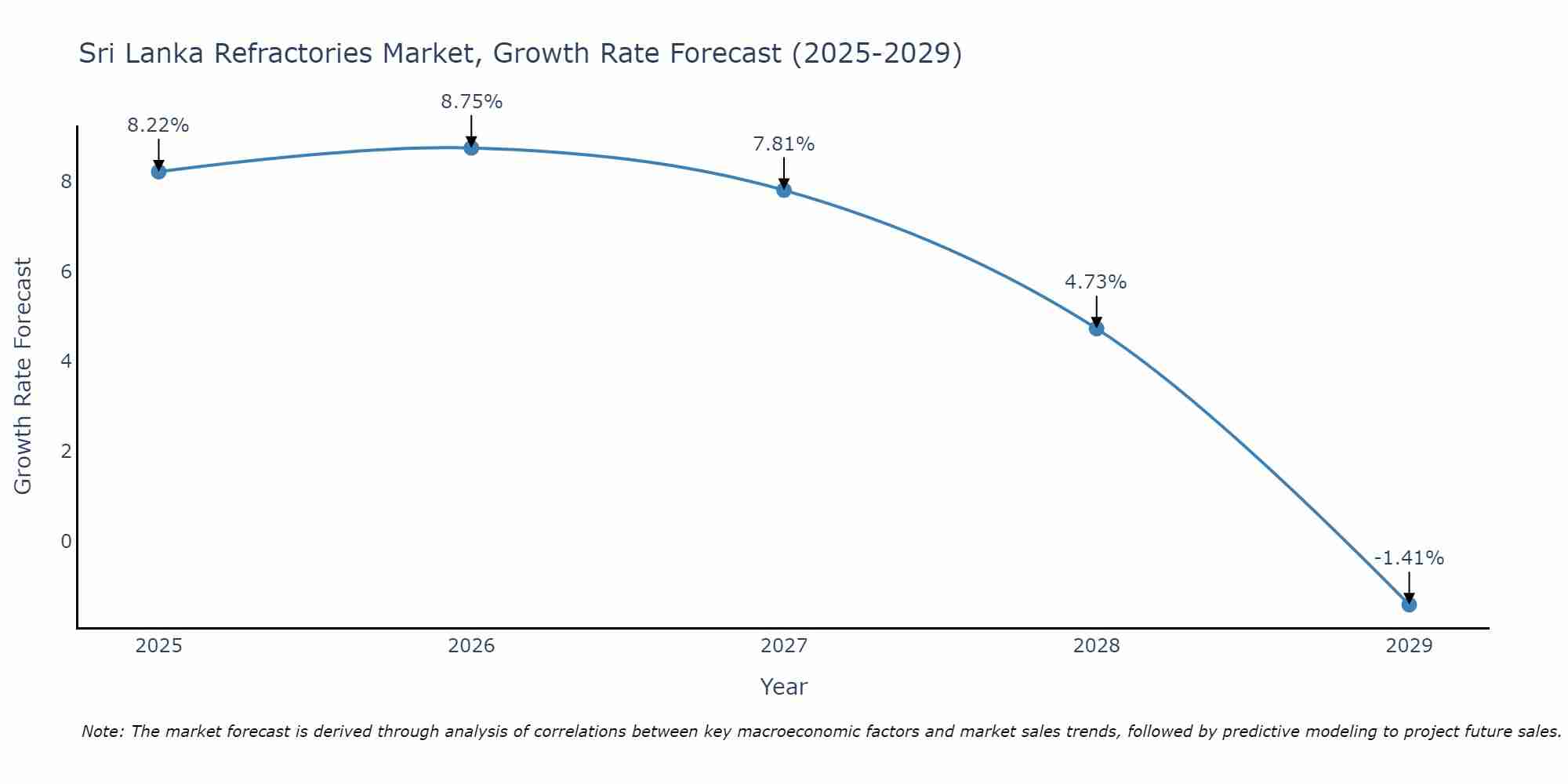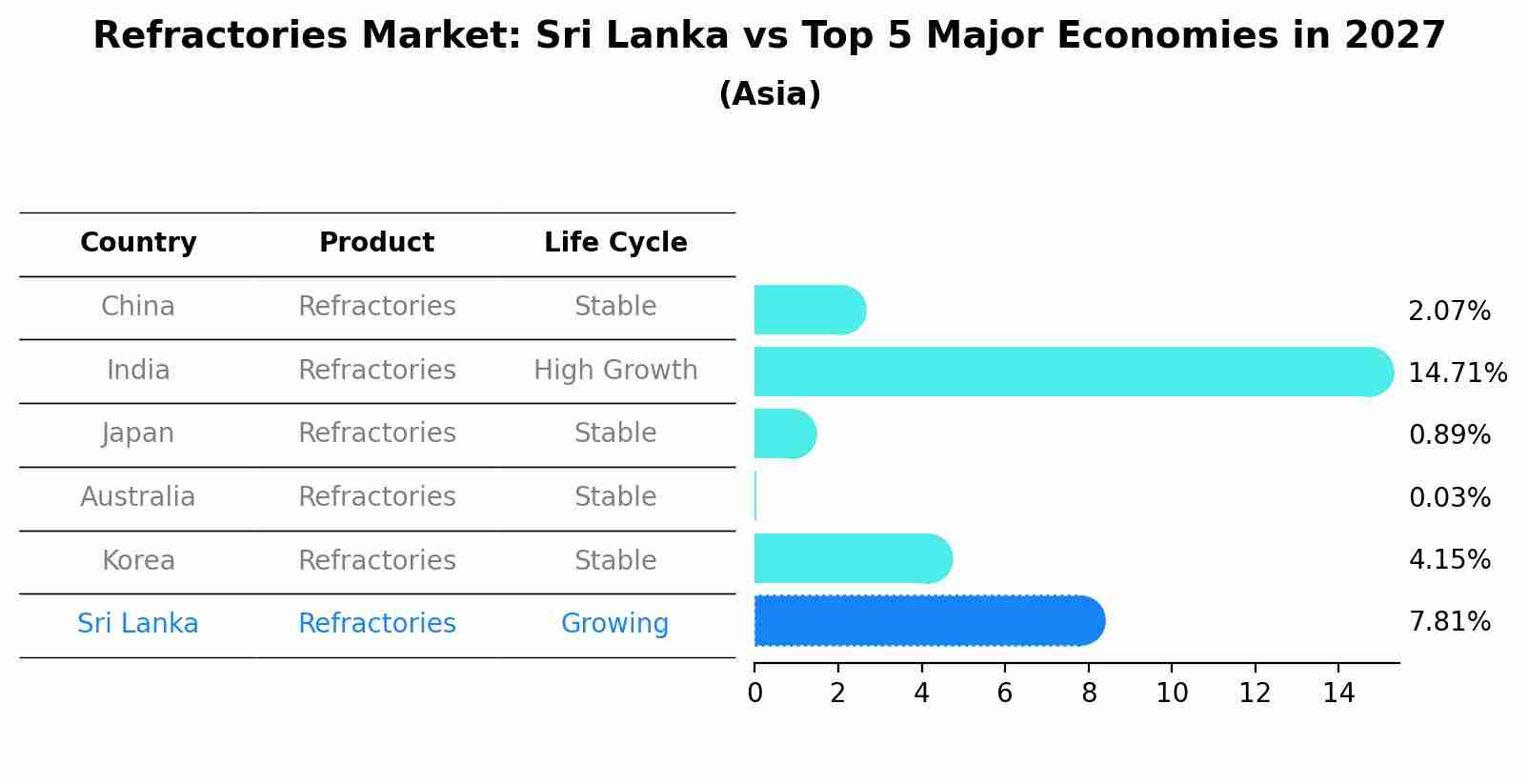Sri Lanka Refractories Market (2020-2026) | Share, Trends, Analysis, Industry, Size, Outlook, Forecast, Companies, Revenue, Growth, COVID-19 IMPACT & Value
| Product Code: ETC008691 | Publication Date: Oct 2020 | Updated Date: Apr 2025 | Product Type: Report | |
| Publisher: 6Wresearch | Author: Ravi Bhandari | No. of Pages: 70 | No. of Figures: 35 | No. of Tables: 5 |
Sri Lanka Refractories Market Size Growth Rate
The Sri Lanka Refractories Market is projected to witness mixed growth rate patterns during 2025 to 2029. Starting at 8.22% in 2025, the market peaks at 8.75% in 2026, and settles at -1.41% by 2029.

Refractories Market: Sri Lanka vs Top 5 Major Economies in 2027 (Asia)
By 2027, Sri Lanka's Refractories market is forecasted to achieve a growing growth rate of 7.81%, with China leading the Asia region, followed by India, Japan, Australia and South Korea.

Sri Lanka Refractories Market Overview
The refractories market in Sri Lanka is critical for high-temperature industrial processes, including metal and cement production. Refractories are materials that can withstand extreme heat and are used to line furnaces, kilns, and reactors. The market is supported by the growth of the construction and manufacturing sectors, which demand high-performance materials for efficient and safe operations.
Drivers of the market
The refractories market in Sri Lanka is driven by industrial activities in steel, cement, glass, and ceramics sectors. Refractory materials are critical for high-temperature applications, providing thermal insulation, corrosion resistance, and structural integrity in furnace linings and kiln structures. Market growth is supported by infrastructure projects, capacity expansions, and advancements in refractory technology enhancing product performance and longevity. Demand for energy-efficient refractory solutions and regulatory compliance also influence market dynamics.
Challenges of the market
The Sri Lanka Refractories Market faces challenges such as the high cost of raw materials and production processes, which can be prohibitive for smaller manufacturers. Additionally, there are technical challenges related to the integration of refractories with existing industrial processes, requiring significant investments in technology and expertise. The market also deals with issues related to the availability of skilled labor and technical expertise required for the production and application of refractories. Ensuring the quality and durability of refractories in various high-temperature applications is another significant challenge. The market also needs to address issues related to competition from alternative materials that offer similar properties at lower costs.
Government Policy of the market
The refractories market in Sri Lanka is influenced by policies that promote industrial efficiency and environmental sustainability. The government sets standards for the quality and performance of refractory materials used in high-temperature applications. There are also incentives for the adoption of advanced refractory technologies that enhance energy efficiency and reduce emissions.
Key Highlights of the Report:
- Sri Lanka Refractories Market Outlook
- Market Size of Sri Lanka Refractories Market, 2019
- Forecast of Sri Lanka Refractories Market, 2026
- Historical Data and Forecast of Sri Lanka Refractories Revenues & Volume for the Period 2016 - 2026
- Sri Lanka Refractories Market Trend Evolution
- Sri Lanka Refractories Market Drivers and Challenges
- Sri Lanka Refractories Price Trends
- Sri Lanka Refractories Porter's Five Forces
- Sri Lanka Refractories Industry Life Cycle
- Historical Data and Forecast of Sri Lanka Refractories Market Revenues & Volume By Form Types for the Period 2016 - 2026
- Historical Data and Forecast of Sri Lanka Refractories Market Revenues & Volume By Shaped Refractories for the Period 2016 - 2026
- Historical Data and Forecast of Sri Lanka Refractories Market Revenues & Volume By Unshaped Refractories for the Period 2016 - 2026
- Historical Data and Forecast of Sri Lanka Refractories Market Revenues & Volume By Product Types for the Period 2016 - 2026
- Historical Data and Forecast of Sri Lanka Refractories Market Revenues & Volume By Non-clay Refractory for the Period 2016 - 2026
- Historical Data and Forecast of Sri Lanka Refractories Market Revenues & Volume By Clay Refractory for the Period 2016 - 2026
- Historical Data and Forecast of Sri Lanka Refractories Market Revenues & Volume By End-users for the Period 2016 - 2026
- Historical Data and Forecast of Sri Lanka Refractories Market Revenues & Volume By Iron & Steel for the Period 2016 - 2026
- Historical Data and Forecast of Sri Lanka Refractories Market Revenues & Volume By Cement for the Period 2016 - 2026
- Historical Data and Forecast of Sri Lanka Refractories Market Revenues & Volume By Non-Ferrous Metals for the Period 2016 - 2026
- Historical Data and Forecast of Sri Lanka Refractories Market Revenues & Volume By Glass for the Period 2016 - 2026
- Historical Data and Forecast of Sri Lanka Refractories Market Revenues & Volume By Others for the Period 2016 - 2026
- Sri Lanka Refractories Import Export Trade Statistics
- Market Opportunity Assessment By Form Types
- Market Opportunity Assessment By Product Types
- Market Opportunity Assessment By End-users
- Sri Lanka Refractories Top Companies Market Share
- Sri Lanka Refractories Competitive Benchmarking By Technical and Operational Parameters
- Sri Lanka Refractories Company Profiles
- Sri Lanka Refractories Key Strategic Recommendations
Frequently Asked Questions About the Market Study (FAQs):
1 Executive Summary |
2 Introduction |
2.1 Key Highlights of the Report |
2.2 Report Description |
2.3 Market Scope & Segmentation |
2.4 Research Methodology |
2.5 Assumptions |
3 Sri Lanka Refractories Market Overview |
3.1 Sri Lanka Country Macro Economic Indicators |
3.2 Sri Lanka Refractories Market Revenues & Volume, 2019 & 2026F |
3.3 Sri Lanka Refractories Market - Industry Life Cycle |
3.4 Sri Lanka Refractories Market - Porter's Five Forces |
3.5 Sri Lanka Refractories Market Revenues & Volume Share, By Form Types, 2019 & 2026F |
3.6 Sri Lanka Refractories Market Revenues & Volume Share, By Product Types, 2019 & 2026F |
3.7 Sri Lanka Refractories Market Revenues & Volume Share, By End-users, 2019 & 2026F |
4 Sri Lanka Refractories Market Dynamics |
4.1 Impact Analysis |
4.2 Market Drivers |
4.3 Market Restraints |
5 Sri Lanka Refractories Market Trends |
6 Sri Lanka Refractories Market, By Types |
6.1 Sri Lanka Refractories Market, By Form Types |
6.1.1 Overview and Analysis |
6.1.2 Sri Lanka Refractories Market Revenues & Volume, By Form Types, 2016 - 2026F |
6.1.3 Sri Lanka Refractories Market Revenues & Volume, By Shaped Refractories, 2016 - 2026F |
6.1.4 Sri Lanka Refractories Market Revenues & Volume, By Unshaped Refractories, 2016 - 2026F |
6.2 Sri Lanka Refractories Market, By Product Types |
6.2.1 Overview and Analysis |
6.2.2 Sri Lanka Refractories Market Revenues & Volume, By Non-clay Refractory, 2016 - 2026F |
6.2.3 Sri Lanka Refractories Market Revenues & Volume, By Clay Refractory, 2016 - 2026F |
6.3 Sri Lanka Refractories Market, By End-users |
6.3.1 Overview and Analysis |
6.3.2 Sri Lanka Refractories Market Revenues & Volume, By Iron & Steel, 2016 - 2026F |
6.3.3 Sri Lanka Refractories Market Revenues & Volume, By Cement, 2016 - 2026F |
6.3.4 Sri Lanka Refractories Market Revenues & Volume, By Non-Ferrous Metals, 2016 - 2026F |
6.3.5 Sri Lanka Refractories Market Revenues & Volume, By Glass, 2016 - 2026F |
6.3.6 Sri Lanka Refractories Market Revenues & Volume, By Others, 2016 - 2026F |
7 Sri Lanka Refractories Market Import-Export Trade Statistics |
7.1 Sri Lanka Refractories Market Export to Major Countries |
7.2 Sri Lanka Refractories Market Imports from Major Countries |
8 Sri Lanka Refractories Market Key Performance Indicators |
9 Sri Lanka Refractories Market - Opportunity Assessment |
9.1 Sri Lanka Refractories Market Opportunity Assessment, By Form Types, 2019 & 2026F |
9.2 Sri Lanka Refractories Market Opportunity Assessment, By Product Types, 2019 & 2026F |
9.3 Sri Lanka Refractories Market Opportunity Assessment, By End-users, 2019 & 2026F |
10 Sri Lanka Refractories Market - Competitive Landscape |
10.1 Sri Lanka Refractories Market Revenue Share, By Companies, 2019 |
10.2 Sri Lanka Refractories Market Competitive Benchmarking, By Operating and Technical Parameters |
11 Company Profiles |
12 Recommendations |
13 Disclaimer |
- Single User License$ 1,995
- Department License$ 2,400
- Site License$ 3,120
- Global License$ 3,795
Search
Thought Leadership and Analyst Meet
Our Clients
Related Reports
- Germany Breakfast Food Market (2026-2032) | Industry, Share, Growth, Size, Companies, Value, Analysis, Revenue, Trends, Forecast & Outlook
- Australia Briquette Market (2025-2031) | Growth, Size, Revenue, Forecast, Analysis, Trends, Value, Share, Industry & Companies
- Vietnam System Integrator Market (2025-2031) | Size, Companies, Analysis, Industry, Value, Forecast, Growth, Trends, Revenue & Share
- ASEAN and Thailand Brain Health Supplements Market (2025-2031) | Strategy, Consumer Insights, Analysis, Investment Trends, Opportunities, Growth, Size, Share, Industry, Revenue, Segments, Value, Segmentation, Supply, Forecast, Restraints, Outlook, Competition, Drivers, Trends, Demand, Pricing Analysis, Competitive, Strategic Insights, Companies, Challenges
- ASEAN Bearings Market (2025-2031) | Strategy, Consumer Insights, Analysis, Investment Trends, Opportunities, Growth, Size, Share, Industry, Revenue, Segments, Value, Segmentation, Supply, Forecast, Restraints, Outlook, Competition, Drivers, Trends, Demand, Pricing Analysis, Competitive, Strategic Insights, Companies, Challenges
- Europe Flooring Market (2025-2031) | Outlook, Share, Industry, Trends, Forecast, Companies, Revenue, Size, Analysis, Growth & Value
- Saudi Arabia Manlift Market (2025-2031) | Outlook, Size, Growth, Trends, Companies, Industry, Revenue, Value, Share, Forecast & Analysis
- Uganda Excavator, Crane, and Wheel Loaders Market (2025-2031) | Strategy, Consumer Insights, Analysis, Investment Trends, Opportunities, Growth, Size, Share, Industry, Revenue, Segments, Value, Segmentation, Supply, Forecast, Restraints, Outlook, Competition, Drivers, Trends, Demand, Pricing Analysis, Competitive, Strategic Insights, Companies, Challenges
- Rwanda Excavator, Crane, and Wheel Loaders Market (2025-2031) | Strategy, Consumer Insights, Analysis, Investment Trends, Opportunities, Growth, Size, Share, Industry, Revenue, Segments, Value, Segmentation, Supply, Forecast, Restraints, Outlook, Competition, Drivers, Trends, Demand, Pricing Analysis, Competitive, Strategic Insights, Companies, Challenges
- Kenya Excavator, Crane, and Wheel Loaders Market (2025-2031) | Strategy, Consumer Insights, Analysis, Investment Trends, Opportunities, Growth, Size, Share, Industry, Revenue, Segments, Value, Segmentation, Supply, Forecast, Restraints, Outlook, Competition, Drivers, Trends, Demand, Pricing Analysis, Competitive, Strategic Insights, Companies, Challenges
Industry Events and Analyst Meet
Whitepaper
- Middle East & Africa Commercial Security Market Click here to view more.
- Middle East & Africa Fire Safety Systems & Equipment Market Click here to view more.
- GCC Drone Market Click here to view more.
- Middle East Lighting Fixture Market Click here to view more.
- GCC Physical & Perimeter Security Market Click here to view more.
6WResearch In News
- Doha a strategic location for EV manufacturing hub: IPA Qatar
- Demand for luxury TVs surging in the GCC, says Samsung
- Empowering Growth: The Thriving Journey of Bangladesh’s Cable Industry
- Demand for luxury TVs surging in the GCC, says Samsung
- Video call with a traditional healer? Once unthinkable, it’s now common in South Africa
- Intelligent Buildings To Smooth GCC’s Path To Net Zero


















